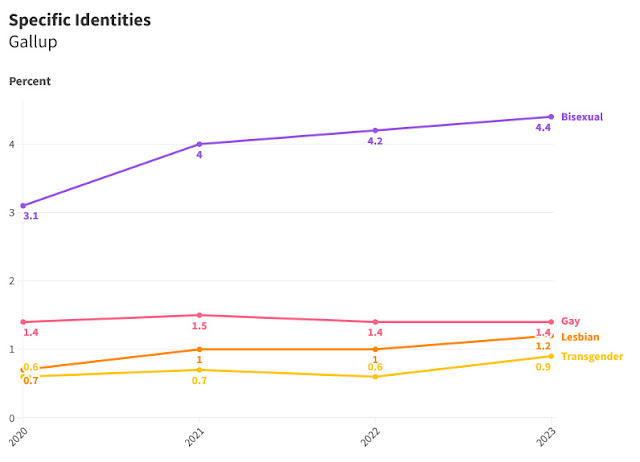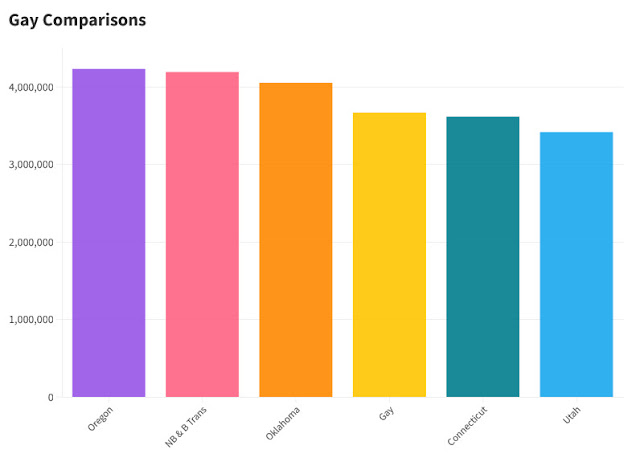Today, we continue our tour of Gallup’s survey by examining the prevalence of LGBT identities across generations.
In 2023, Gallup asked more than 12,000 US adults whether they identify as heterosexual, lesbian, gay, bisexual, transgender, or something else.
Gallup calculated the percent of each generation that identifies as LGBT, which can be seen in the graph below.
The percent of each generation of US adults who identify as LGBT is about twice as large as the generation that preceded them.
As you can see, 22.3% of Gen Z adults identify as LGBT.
That means more than 1 in 5 Gen Z adults are LGBT.
Gen Z adults were born from 1997 to 2005. They were 18 to 26 years old in 2023.
Gallup also provided the percent of each generation of US adults who identified with specific LGBT identities.
I created two bar graphs using data from this table.
The first bar graph allows readers to compare LGBT identities within individual generations.
The bars are color coded for specific LGBT identities, as shown in the legend near the top.
The second bar graph divides the data by specific LGBT identities to allow readers to compare the prevalence of those identities by generation.
The bars on this graph are color coded for different generations, as shown in the legend near the top.
The biggest takeaway from this data set is the two largest values are for bisexual Gen Z adults, and bisexual Millennials.
A total of 15.3% of Gen Z adults are bisexual, and 5.9% of Millennials are bisexual.
It’s also worth noting that there is a general pattern that each specific LGBT identity is more common in each younger generation, although that pattern isn’t true for all values.
Gen Z identities by year
Next, let’s take a closer look at LGBT identity among Gen Z adults.
Gen Z adults were born from 1997 to 2005. They were 18 to 26 years old in 2023.
I created three line graphs showing the percent of Gen Z adults who identified with specific LGBT identities in each of Gallup’s four most recent surveys.
The first graph demonstrates the total values for LGBT identity tracks fairly well with the values for bisexual.
The second graph, which only includes specific identities, demonstrates how much larger the values for bisexual are than the values for everything else.
The third and final graph shows a close up of the bottom of the previous two graphs.
As you can see, the order of lesbian, transgender, and gay identities among Gen Z adults changes from year to year.
The values for these identities are all fairly close together, particularly in the most recent survey.
The line for “other” represents volunteered responses not specifically listed in Gallup’s question, the most common of which are pansexual and asexual.
Here is a table showing the values used to create the line graphs shown above.
Millennial identities by year
Now, let’s take a closer look at specific LGBT identities among Millennials, based on Gallup’s surveys.
Millennials were born from 1981 to 1996. They were 27 to 42 years old in 2023.
As you can see, the percent of Millennials who identify as LGBT tracks fairly well with the percent of Millennials who identify as bisexual.
This graph only shows the prevalence of specific LGBT identities among Millennials.
Bisexual is consistently the most common LGBT identity among Millennials, by a significant margin.
Gay is consistently the second most common LGBT identity among Millennials.
For the past three years, more Millennials have identified as lesbian than transgender.
But in 2020, more Millennials identified as transgender than lesbian.
Once again, “other” represents volunteered responses not specifically listed in Gallup’s question, such as pansexual and asexual.
Here is the table of values used to create the line graphs for Millennial LGBT identities.
Bisexuals by Generation
Next, let’s compare bisexual identification by generation.
Bisexual is consistently the most prevalent LGBT identity in Gallup’s surveys.
Here is a line graph showing the percent of each generation of US adults who identify as bisexual.
The values for bisexual Gen Z adults are consistently significantly higher than the bisexual values for other generations.
The overall value for bisexual US adults is consistently between the values for Millennials and Gen X.
We see a nearly consistent pattern where each generation’s prevalence of bisexual identification is more common than the generation that came before.
The only exception is 2020, when 0.3% of both Baby Boomers and the Silent Generation identified as bisexual.
Here is the table of values used to create the line graph showing bisexuals by generation.
Gen Z identities
Gallup has the best data regarding the prevalence of minority sexualities in the US.
But the Pew Research Center has the best data regarding the prevalence of minority gender identities in the US.
I first examined Pew's results in "Gender Identity in the United States."
Here are the prevalence rates for several LGBT identities among Gen Z adults, based on surveys from Gallup and the Pew Research Center.
Identity Gen Z Adults
Bisexual 15.3% (Gallup, 2023)
Nonbinary 4.1% (Pew, 2022)
Lesbian 3.0% (Gallup, 2023)
Binary Trans 2.8% (Pew, 2022)
Gay 2.6% (Gallup, 2023)
I created a bar graph based on these values.
As you can see, bisexual is by far the most common LGBT identity among Gen Z adults.
Nonbinary comes in second, followed by lesbian, binary trans, and gay.
Acronyms are often used to collectively describe sexual and transgender minorities.
"LGBT" is the most common form of the acronym.
Sometimes, people use longer forms of the acronym, such as "LGBTQIA".
In “Thoughts on the Acronym,” I imagined what the acronym would look like if its letters were organized by how common LGBT identities were among Gen Z adults.
Based on the data available at the time, that acronym was “BNGTLAI.”
We don’t have data regarding the prevalence of Asexual and Intersex identity among Gen Z adults, so I put those letters at the end.
Gallup’s latest data has changed the order of LGBT identities among Gen Z adults.
Now that acronym would be “BNLTGAI.”
Reordering the acronym based on the survey data for Gen Z makes for a fun thought experiment.
But I don't think we should replace the much more familiar "LGBT," at least not based on survey data for Gen Z.
Considering the variability of the order of the less common Gen Z identities, it would be rather impractical to update the acronym every year based on survey data.
In the next article, we’ll compare Gallup’s LGBT data for men and women.
For the first time, Gallup has provided data for nonbinary respondents.
We’ll take a close look at that as well.
























